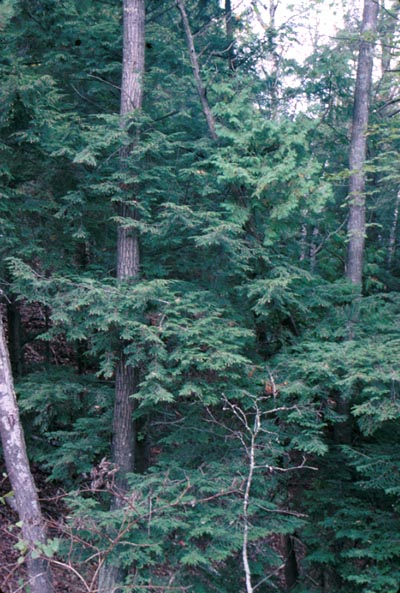THE TANBARK INDUSTRY
The Eastern Hemlock (Tsuga canadensis) tree was widespread throughout northern lower
Michigan (above the floristic tension zone) and the UP, in presettlement times. Hemlock
had many uses during the late 19th and early 20th centuries. It grew among white pine and
northern hardwoods and these trees grew well together in their environment. Hemlock grows
on somewhat poorly-drained soils with low fertility, but was also very successful in the
more fertile uplands.

Source: Photograph by Randy Schaetzl, Professor of Geography - Michigan State University
For a long time it was considered worthless, but then it was discovered
that the bark of the hemlock, otherwise known as tanbark, could be used for tanning
leathers by extracting tannic acid from the bark itself. When it was discovered that
tannic acid could be extracted from the bark of the hemlock the acid was used to tan hides
and convert it to leather.
One city in Michigan in particular, took advantage of hemlock tanbark:
Boyne City. BC was a lumbering town and the local lumbering company, The White Lumbering
Company, owned by W.H. White, knew that the bark of the hemlock could be used to his
advantage. White convinced the tanner W.S. Shaw to open a tannery and the two of them
would work together and share the profits. It opened in 1904 and by 1907, Shaw’s
tannery was producing six million pounds of leather annually. From Boyne City, among
others, tanbark was transported to some of the larger industrial cities. It was shipped
from Boyne City through Lake Michigan and into Chicago, Racine, Kenosha and Milwaukee.
The stripping of bark from the hemlock contributed additional jobs to
loggers in the "off-season", as the bark stripping season was from May to July.
Because hemlock did not reproduce regularly, due to the need of specific climate and
soils, and the introduction of other methods for tanning hides the tanbark industry
disappeared. Today, hemlock is no longer a common tree in Michigan, in part due to the
heavy cutting during the heyday of the tanbark industry.
Based on a paper by Katherine Steely, GEO 333, Spring 2000.
This material has been compiled for educational use only, and may not be reproduced without permission. One copy may be printed for personal use. Please contact Randall Schaetzl (soils@msu.edu) for more information or permissions.